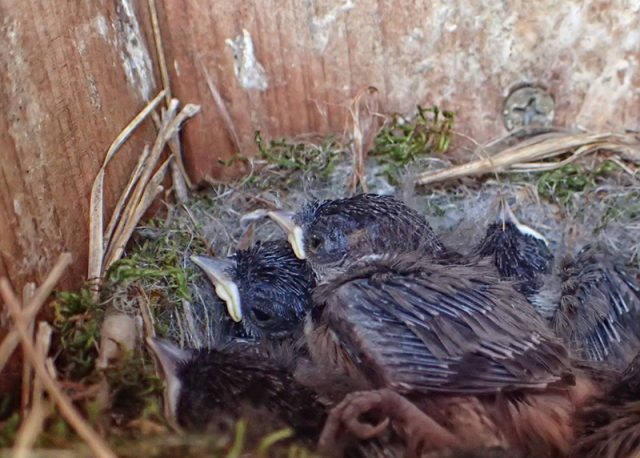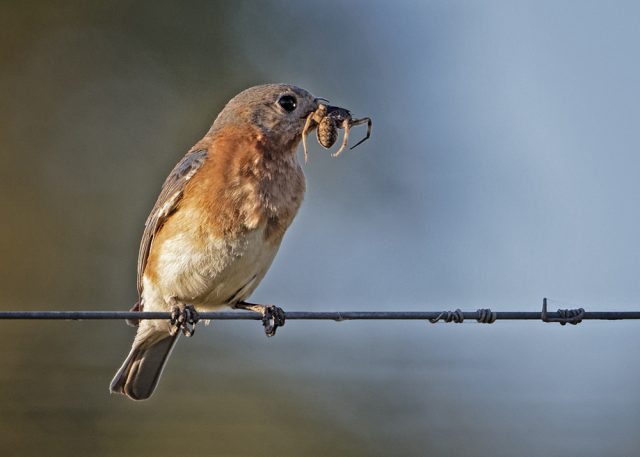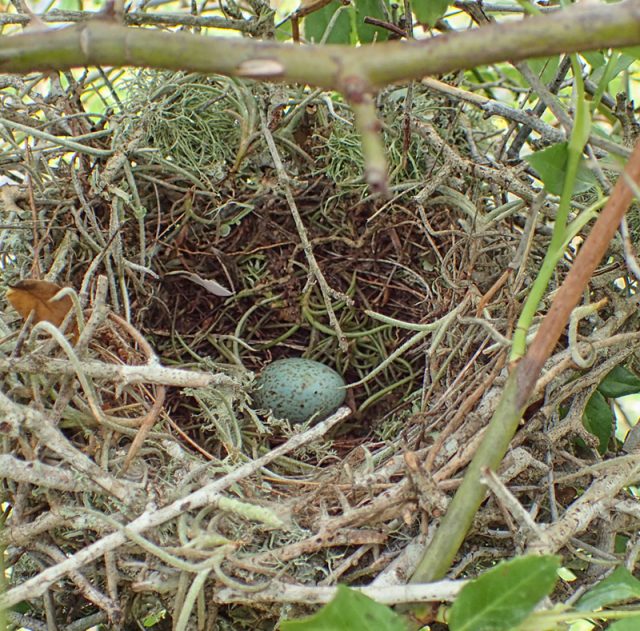
These four nestlings were “mystery birds” for several days. I was finally able to observe the speedy little bird that zipped in and out of the nest box with food for the babies. Karen Benson Photo.
It is the Season for Baby Birds! (Karen Benson)
Our local birds have been getting a jump on spring. The pair of bluebirds that hung around the pasture all winter began nesting in early March. They occupied the nest box on the east end of the vineyard. The babies hatched out over two weeks ago, and after an intense period of feeding, they fledged on Monday. The whole process took less than a month! Of course, the young will follow their parents around for a few more weeks, learning how to catch bugs, but they are nearly on their own.
The other nest box’s occupants are a mystery. It too is a bluebird house. When I checked this nest box a week ago, I gently flipped the latch and lowered the front panel. I was almost knocked over by a rapidly exiting little bird. I didn’t get a good look at the bird, so I don’t know what species is using the nest box. The four nestlings are now growing feathers and they appear to be gray. Our best guess is that the birds are Black-crested Titmice, but they could be Carolina Chickadees. Both these species are cavity nesters.

Baby birds grow fast and require a lot of food to do so. This mama bluebird is bringing in yet another choice morsel for her three nestlings. This is likely the 50th meal of the day that she and her mate have brought to their young. Robert Benson Photo.
You are probably aware that only certain species use cavities for nesting. Those that do include the woodpeckers, kestrels, titmice and chickadees, Brown-crested Flycatchers, small owls, and starlings, Purple Martins, nuthatches, and some wrens. The nest site can be a simple crevice, a hollow limb, an excavated cavity made by a woodpecker, a rotted-out fence post or pipe, an old yucca, a mailbox, a man-made nest box, or even a tractor or farm implements! Three species of ducks (Wood Ducks, Buffleheads, and Black-bellied Whistling-Ducks) also use hollow trees and nest boxes made for them. House Sparrows are notorious for using partially rotted-out house eaves. If it looks like a suitable space, cavity-nesters will check it out. We had a pair of Bewick’s Wrens try to build a nest in a hollow section of our pick-up truck’s paneling! We had to close off the gap with a glob of modeling clay.
When we think of a bird’s nest though, our first thought is of a cup-shaped structure. Many species of raptors, doves, and songbirds build such nests out of twigs, grasses, feathers, lichens, and spider webs. The cup can be in a shrub or tree, or even on the ground. Kentucky Warblers construct their nests at the base of a tree or in a weed clump. Cup nests can be well concealed or very exposed. It is very difficult to find a Painted Bunting nest, hidden in the thick brush as they are.
On the other hand, Northern Mockingbirds seem heedless of who is watching while they build. A pair of mockingbirds flew in and out of a rosebush within a few feet of our heads to build their nest. It is easy to locate that nest, but quite difficult to get near it. The rose thorns and the thorny twigs of the cup nest itself, have given the mockingbirds great protection.
Swallows use mud as the main ingredient in their nests. Beakful by beakful, the swallows carefully plaster the tiny balls of mud together until they have a lipped cup (Cave Swallows) or a jug-shaped nest (Cliff Swallows). Barn Swallows use mud and vegetation to produce a sturdy bowl, often on the wall of a barn or house.
Chimney Swifts take small twigs and cement them together with their saliva. The gluey saliva also sticks the half-cup of twigs to the wall of the chimney. Swifts cannot perch on limbs or wires like other birds. They must hang by their four long-clawed toes, all of which face forward, on the rough wall of the chimney. Sadly, for the swifts, chimneys are becoming things of the past as people prefer to heat their homes more efficiently. Fortunately, swift-lovers have devised special free-standing towers or chimneys to attract the declining number of these birds.

Northern Mockingbirds’ nests are usually easy to find, but very hard to get close to. You can watch the parents carrying sticks and thorny twigs to their chosen site for several days. Our pair of mockingbirds built their nest in a dense, thorny climbing rose bush. Karen Benson Photo.
A few species make no nest to speak of at all. Nighthawks, Killdeer and most shorebirds simply scrape out a shallow depression in gravel or sand. Their eggs are heavily speckled and thus camouflaged in the gravel. So good is this camouflage, that if you take your eyes off the eggs for even a second, you might not find the nest again. Mama Killdeers use this fact, to lure you, or other predators away from the nest by flying a short distance and dragging a wing. It appears the adult bird has a broken wing and as it flutters away and cries, the predator’s attention is drawn to it. The predator takes its eyes off the eggs, and then cannot find them again. Clever, no?
Ah, the identity of the mystery birds in the bluebird box: I spent a few minutes watching from behind a tree fifty feet away. It was late afternoon, prime feeding time for baby birds. A speedy little bird dropped out of the opening and flew to a hackberry tree. Moments later the adult flew straight back in the hole without stopping. It was amazingly fast! It peeked out just long enough for me to focus my binoculars on its black-and-white patterned head. It was a Carolina Chickadee! Mystery solved!
If you would like to offer comments, please click through to the discussion page
